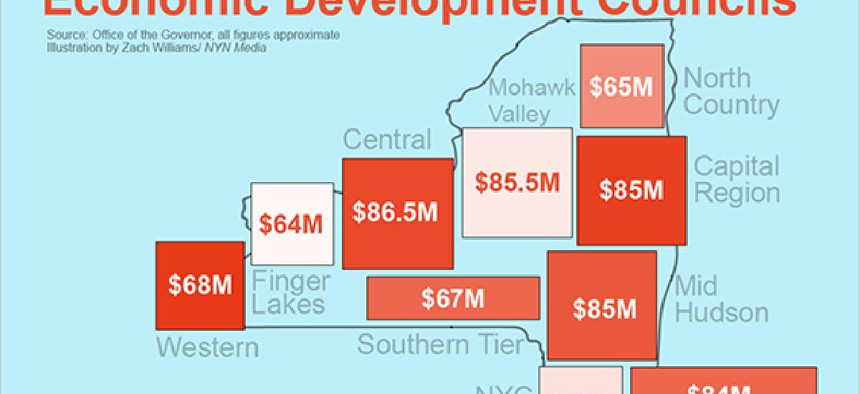Economic pitches win state funding for New York nonprofits

Illustration by Zach Williams/ NYN Media
The proposal was just for a building where veterans could gather in Central New York, but a Madison County nonprofit first needed a place to start.
Years before veterans could engage in peer-to-peer healing for depression and post-traumatic stress disorder, Sara Bollinger, grants coordinator at the nonprofit Clear Path for Veterans, had to find a way to fund a proposed $2 million capital expansion to match the nonprofit’s expanding social services. So Bollinger decided to go after a single state grant that could fund nearly a quarter of the entire effort. But to do so, she would have to explain the proposal in purely dollars and cents terms.
But Bollinger wasn’t the only grant writer who faced such a dilemma while navigating through the bureaucratic tedium of winning a piece – whether big or small – of the $755 million in grants from state regional economic development councils. In the end, it would all come down to who had the best economic pitches – and provided every detail required before the July deadline.
Nearly five months later, that time turned out to be well-spent.
“The format itself is very specific. It’s not that it’s hard to complete, you just have to pay attention to the details,” Bollinger said.
By then, she knew that her organization was among the nonprofits who won a small fraction of the 1,041 grants awarded on Dec. 13. Most of them went to public agencies, universities, businesses and development groups, but nonprofits who argued the economic benefits of their social services won big. Clear Path for Veterans received $483,000 for the proposed veterans center. A proposed $700,000 commissary for food trucks will expand a program for formerly incarcerated youth in Brooklyn. And an emphasis on job training will invest $76,875 into efforts at the Mohawk Valley Resource Center for Refugees to provide employment services and training access to refugees and immigrants, and ultimately to combat poverty in the area.

The Mohawk Valley Resource for Refugees won a state grant to expand economic opportunities for refugees. (Contributed)
It’s a competition that rewarded a balanced enthusiasm for dollars and the people they can help, according to Shelly Callahan, executive director of the resource center.
“I get really excited thinking about workforce development because I really think it changes people lives,” she said.
The 10 regional economic development councils, which are made up of nonprofit, business, community and political leaders, have awarded more than $1 billion in funding since being established in 2011. They do so as part of Gov. Andrew Cuomo’s effort to jump-start the state economy.
In remarks announcing the 2017 grants, Cuomo credited the councils and grants with reducing unemployment and reversing economic stagnation through initiatives that promote regional economic niches like the medical industry and solar power in Buffalo and drone research in Syracuse.
While people have praised the grants for injecting money into local economies, others have also questioned whether they realize their lofty economic goals. Critics have asked whether job projections have been realized from a $5 million wastewater project in Ogdensburg, a $200,000 pasta sauce factory in the Southern Tier and $108,400 to promote Ticonderoga through Star Trek.
An investigation of projects in the mid-Hudson Valley by the Times Herald-Record found that grant totals were inflated by tax credits and bonding authority. Of the $475.9 million awarded to the region since 2011, about $300 million in grants were approved.
The economic benefits also remain suspect, according to Ken Girardin, a policy analyst at the Empire Center for Public Policy.
“Despite six years of continuous spending, New York is still growing more slowly than the rest of the country, and upstate – where the councils were supposed to be difference-makers – is lagging even further behind,” Girardin told the Times Herald-Record. “It clearly has not changed upstate’s trajectory.”
But that does not mean that, with time, the grants won’t lead to something concrete for nonprofits with patience. Veterans could one day mingle in Chittenango, Madison County, but Clear Path for Veterans still has a lot of work ahead before it receives the state money.
Bollinger, however, has learned to be patient. A capital fundraising campaign will begin in 2018 to raise the funds necessary to break ground in 2020 or 2021, she said. Only when they have funding commitments for the whole $2 million project will the $483,000 grant reimburse them for their costs.
For a nonprofit to succeed with grants from regional economic development councils, the organization must have patience that can outlast the application process by several years, according to Bollinger.
“It’s definitely a long-term strategy,” she said.
NEXT STORY: NYN Media Buzz: Dec. 27, 2017